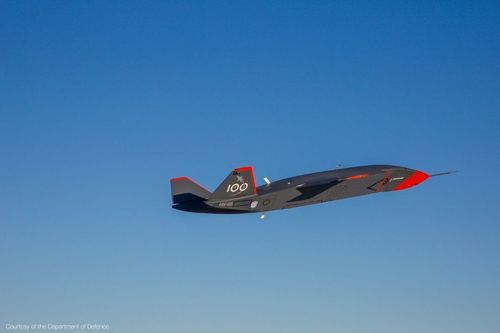Boeing Australia’s unmanned combat drones have up to 9,000 cubic inches in payload space

Boeing Australia’s unmanned combat drones have up to 9,000 cubic inches in payload space
Boeing Australia’s new unmanned combat drone is set to be built in Australia, the first military combat aircraft that country will produce in more than half a century.
Called ‘MQ-28A Ghost Bat,’ the AI-powered drone was named after an Australian native mammal known for teaming together in a pack to detect and hunt by the Australian Government and Royal Australian Air Force (RAAF).
In a similar fashion, the drone is designed to fly alongside crewed fighters to jam radars, conduct surveillance and fire on designated targets. These drones add to the tactical capabilities of fighter jets without incurring the cost of buying more aircraft.
The drone has an 8.5 ft long modular nose cone with 9,000 cubic inches of internal volume for payloads, which are hardware it carries to accomplish its mission such as explosives. The noses can be swapped put depending on mission requirements. The units also have integrated sensor packages onboard.
So far, the unit has undergone three test flight series that Boeing said have been successful. The Ghost Bat will go through several further developments and tests throughout this year, with plans to focus on sensor and missionization capabilities, a Boeing statement said.
“These requirements will continue to expand as Boeing moves towards the aim of delivering an operational capability for the Australian Defense Force.”
Australia’s drone acquisition affirms its commitment to increased defense spending amid growing tensions with China. Last year, the country signed a trilateral security pact with the U.K. and U.S. to acquire nuclear-powered submarines.
New name
Internationally, this Boeing product is called the Airpower Teaming System or ATS. The RAAF initially dubbed Boeing’s drone ‘Loyal Wingman’ but the new name was announced recently at a dedicated ceremony held at RAAF Base Amberley, Queensland.
The newly announced designation “reflects the unique characteristics of the aircraft’s sensors and Intelligence, Surveillance and Reconnaissance abilities, and is a fitting name for this pioneering capability,” said Glen Ferguson, director Airpower Teaming System Australia and International.
Additional reporting from Deborah Yao
About the Author(s)
You May Also Like


.jpg?width=700&auto=webp&quality=80&disable=upscale)
.jpg?width=700&auto=webp&quality=80&disable=upscale)
.jpg?width=700&auto=webp&quality=80&disable=upscale)
.jpg?width=300&auto=webp&quality=80&disable=upscale)
.jpg?width=300&auto=webp&quality=80&disable=upscale)
.jpg?width=300&auto=webp&quality=80&disable=upscale)

